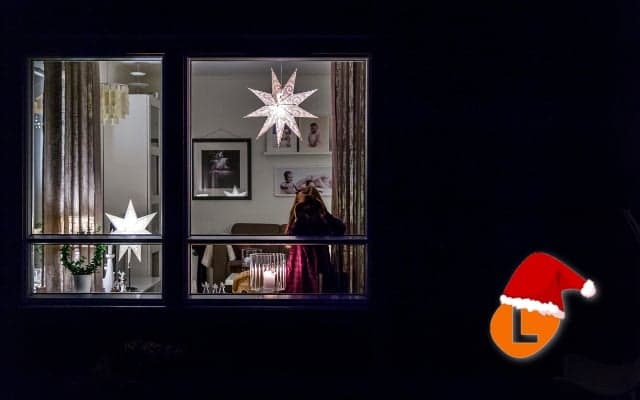#SwedishChristmas: The tradition with a surprising connection to H&M

Every day until Christmas Eve, The Local explains the unique history behind Swedish Christmas traditions in our own Advent calendar.
This article is available to Members of The Local. Read more articles for Members here.
Like its cousin the adventsljusstake (Advent candelabra), the Swedish adventsstjärna (Advent star) that brightens windows during the Christmas season was adapted from a German tradition. Also like the Advent candelabra, which was brought to Sweden by Marie Cederschiöld, the Advent star owes its initial introduction in Sweden to a woman.
The German Herrnhuter Stern (Moravian star), which typically has 25 or 26 points but can feature anywhere from 20 to 110, dates back to the mid-1800s. Representative of the Star of Bethlehem, the star originated under the auspices of the Moravian Church, a Protestant denomination of Christianity based in the German town of Herrnhut. By the late-1800s, the stars were being produced and sold in a Herrnhut bookstore and, later, a factory.
Born in Herrnhut in 1886, Julia Aurelius would have grown up with the stars decorating the windows of her family home during the period of Advent. When she married Swedish theologian Erik Aurelius in 1912 and moved with him to Lund, she brought the tradition with her. As a prominent and respected family in Lund, they helped popularize the tradition in the area.
In 1934, the popularity of the German Advent stars inspired a paper dealer in Lund to begin importing them from Germany, where they were by then being mass-produced, and selling them under the Swedish term adventsstjärna. It wasn't long before another emerging star picked up on the idea and made it distinctively Swedish.
In 1941, Swedish entrepreneur Erling Persson began mass-production of a seven-point cardboard adventsstjärna that he eventually branded Tindra Kristall. According to the Nordiska Museet in Stockholm, during the Second World War, some 200,000 of these Advent stars were sold at a price of 2.5 Swedish kronor each. It became so common to see the Tindra Kristall adventsstjärna in Swedish windows during the Christmas season that it earned the nickname "the Proletarian star". In 1947, Persson's personal star also rose further when he founded the clothing store known today as H&M.
Over time, a variety of styles of Swedish Advent stars made with a range of materials have been introduced, providing anything but a common display. They light up Swedish windows throughout the month of December and into January, making a sad disappearance on January 13th when the Swedish Christmas season officially ends.
Each day until Christmas Eve, we're looking at the story behind one Swedish festive tradition. Find the rest of our #SwedishChristmas series HERE.
Comments
See Also
This article is available to Members of The Local. Read more articles for Members here.
Like its cousin the adventsljusstake (Advent candelabra), the Swedish adventsstjärna (Advent star) that brightens windows during the Christmas season was adapted from a German tradition. Also like the Advent candelabra, which was brought to Sweden by Marie Cederschiöld, the Advent star owes its initial introduction in Sweden to a woman.
The German Herrnhuter Stern (Moravian star), which typically has 25 or 26 points but can feature anywhere from 20 to 110, dates back to the mid-1800s. Representative of the Star of Bethlehem, the star originated under the auspices of the Moravian Church, a Protestant denomination of Christianity based in the German town of Herrnhut. By the late-1800s, the stars were being produced and sold in a Herrnhut bookstore and, later, a factory.
Born in Herrnhut in 1886, Julia Aurelius would have grown up with the stars decorating the windows of her family home during the period of Advent. When she married Swedish theologian Erik Aurelius in 1912 and moved with him to Lund, she brought the tradition with her. As a prominent and respected family in Lund, they helped popularize the tradition in the area.
In 1934, the popularity of the German Advent stars inspired a paper dealer in Lund to begin importing them from Germany, where they were by then being mass-produced, and selling them under the Swedish term adventsstjärna. It wasn't long before another emerging star picked up on the idea and made it distinctively Swedish.
In 1941, Swedish entrepreneur Erling Persson began mass-production of a seven-point cardboard adventsstjärna that he eventually branded Tindra Kristall. According to the Nordiska Museet in Stockholm, during the Second World War, some 200,000 of these Advent stars were sold at a price of 2.5 Swedish kronor each. It became so common to see the Tindra Kristall adventsstjärna in Swedish windows during the Christmas season that it earned the nickname "the Proletarian star". In 1947, Persson's personal star also rose further when he founded the clothing store known today as H&M.
Over time, a variety of styles of Swedish Advent stars made with a range of materials have been introduced, providing anything but a common display. They light up Swedish windows throughout the month of December and into January, making a sad disappearance on January 13th when the Swedish Christmas season officially ends.
Each day until Christmas Eve, we're looking at the story behind one Swedish festive tradition. Find the rest of our #SwedishChristmas series HERE.
Join the conversation in our comments section below. Share your own views and experience and if you have a question or suggestion for our journalists then email us at [email protected].
Please keep comments civil, constructive and on topic – and make sure to read our terms of use before getting involved.
Please log in here to leave a comment.